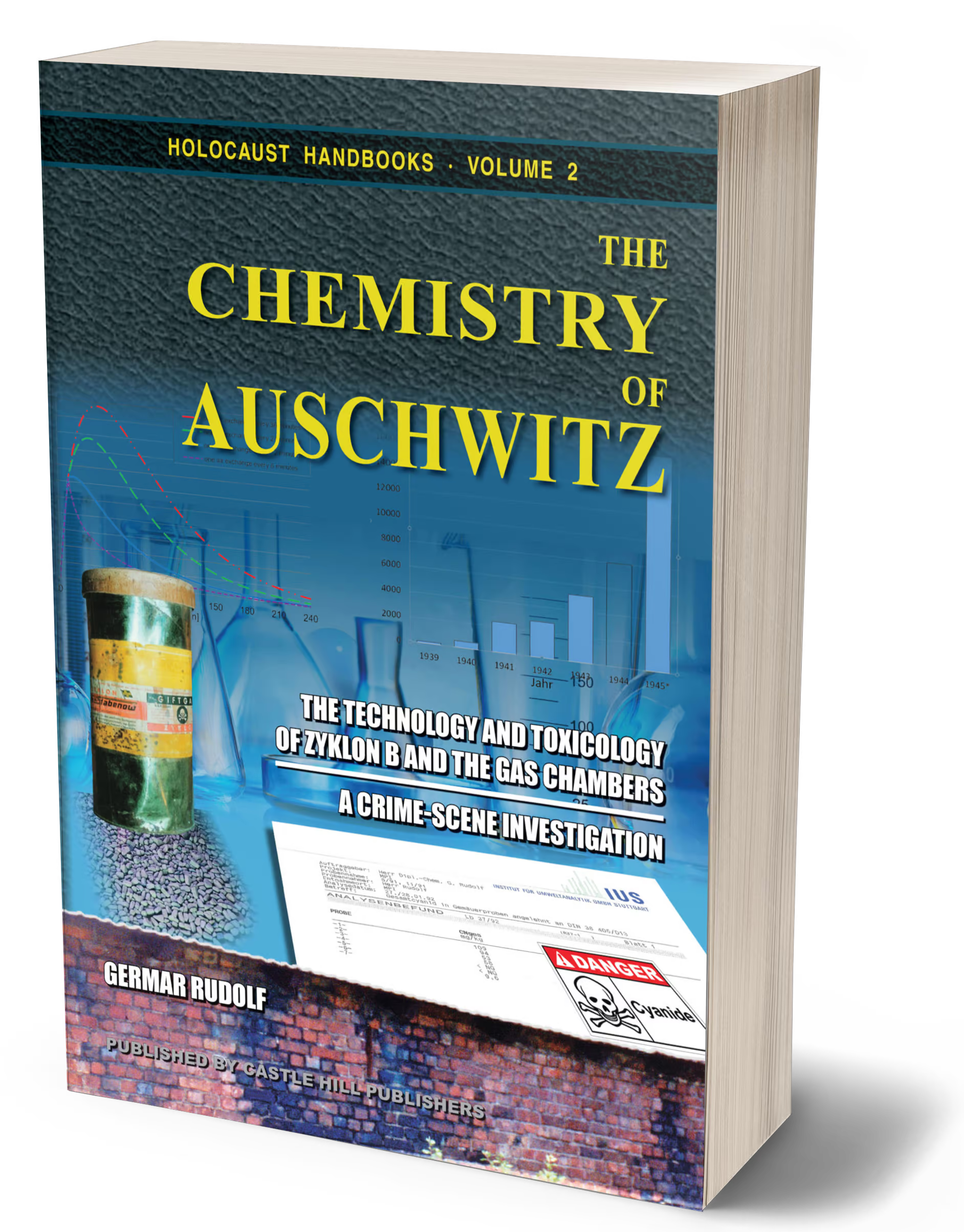Holocaust Handbooks, Volume 2:
The Chemistry of Auschwitz
The Technology and Toxicology of Zyklon B and the Gas Chambers – A Crime-Scene Investigation
By: Germar Rudolf

| Item Properties | |
|---|---|
| Published by: | London: Armreg Ltd |
| ISBN: | 978-1-911733-74-4 |
| Pages: | 456 |
| Size: | 9×6 |
| Edition No.: | 2, reprint |
| Release Date: | 1/2024 |
| Illustrations: | 129 color; 102 b+w |
| Features: | Index, Bibliography |
Auschwitz was a center of chemistry. The German chemical industry built gigantic factories for rubber, fuel, lubricants and methanol there, and the SS experimented with natural sources of rubber. But that’s not what people associate with the name “Auschwitz.” They think of gas chambers and Zyklon B, which are two entirely chemical things as well.
The gas chambers of Auschwitz have been called the epicenter of human suffering. More human beings are said to have died a violent death there than on any other place on earth in the history of mankind.
The biggest crime scene of history, in terms of its death toll, not only demands the utmost respect for its victims, but should also attract the most-intensive attention of forensic researchers to find out what exactly happened, and how. Or so one might think.
Forensic research on Auschwitz, however, has always been controversial. Investigating the gas chamber mass murder is considered a blasphemous act, a way of disturbing the peace of the dead.
While respecting the victims, whether of foul play or of circumstance, this study nonetheless tries to conduct Auschwitz research on the basis of the forensic sciences, where material traces of the crime and their interpretation reign supreme. Although it is generally agreed that no autopsy of any victim has ever been performed, most of the claimed crime scenes – the chemical slaughterhouses called gas chambers – are still accessible to forensic examination to a greater or lesser degree. So, how did these gas chambers of Auschwitz look like? How did they operate? What were they used for? In addition, the infamous Zyklon B can also be examined. What exactly hides behind this ominous name? How does it kill? And what effect has it on masonry? Does it leave traces that can be found still today?
These and many other questions are thoroughly examined in this study. The horror of Auschwitz is meticulously dissected, and thus, for the first time, it really becomes comprehensible.
“I am extraordinarily impressed. To my knowledge, you are the first expert in Germany who has addressed this particular topic in a scholarly impeccable and well-founded way. It is not for me to attribute an ice-breaker function to your expert report. It is easy to see which political-historical effects will originate from it, though its entire dimension cannot yet be estimated.” — Prof. Dr. Hellmut Diwald, Historian, January 22, 1992
“I read it with great interest. […] My impression is, however, that this expert report is an important contribution to a very important question which, since the ‘Leuchter Report,’ needs to be answered urgently. […] One can only very much hope that the well-known tactics of hushing up is not applied to your expert report, but that critical responses and comments will be made.” — Prof. Dr. Ernst Nolte, Historian, January 28, 1992
“For me, the significance of receiving your report rests on the fact that it substantially contributes to our stock of knowledge. With many of my collegues active in the field of contemporary history, I am overjoyed and thankful for you having initiated this research activity. Of course, I am even more delighted regarding the results of your accurate scientific investigation.” — Prof. Dr. Werner Georg Haverbeck, Historian, January 31, 1992
“I calmly read your report! It gives me hope to realize that a representative of the younger generation courageously sets out, with scientific thoroughness, noticeable great expertise, and corresponding investigative curiosity, to get to the bottom of a controversial question that is of worldwide significance! The result is clear and unequivocal! True facts cannot be suppressed forever! I wish that your work will make the breakthrough!” — Prof. Emil Schlee, Historian, April 1, 1992
“[…] I sincerely hope that all statements about this topic would obviously be based on long and intensive work such as yours. Most of it is certainly unverifiable for the layman, but the photographs are already quite informative. […]” — Prof. Dr. Ernst Nolte, Historian, January 6, 1993
“Rudolf is a young scientist who tried to prove in an excellently layed-out work with tables, graphics, and so on, that the gas chambers were technically impossible. […] These scientific analyses are perfect.” — Hans Westra, Anne-Frank-Foundation, BRT 1 TV (Belgium), Panorama, April 27, 1995
“All in all, he relies on literature which was written long before this report was completed, and the report must be described as scientifically acceptable.” — Prof. Dr. Henri Ramuz, Chemist, interrogated as expert witness about this book by the Swiss Court at Châtel-St.-Denis, May 18, 1997
One of our Holocaust Documentaries explores “The Chemistry of Auschwitz” in depth. Watch it right here, or at the movie’s dedicated page here.
This book’s PDF file on Archive.org: https://archive.org/details/The-Chemistry-of-Auschwitz-Technology-Toxicology-of-Zyklon-B-and-Gas-Chambers-2nd-edition-2024 (in case mainstream sites block or ban links to our site)
Download Options:
